It’s nearing election time and so we are busy discussing the issues that really matter like personality, popularity and a winning smile. We digress. There are still many hot potatoes to throw about this time around, though a few have gone cold. Like a capital gains tax; think of the revenue opportunities missed there in the past few years. Asset sales; the good ones have since been flogged, and there’s not much being said about foreign investment, more about foreigner inflow. Foreign investment has its pros and cons. Added capital begets growth and brings new technology and practices, though foreign influence can also see strategic assets pass out of local control, and they can be stripped of their value. It’s kind of what Ford did to both Volvo and Land Rover during its time in charge of these brands. Any hope turned to despair and Ford unloaded them both in the big GFC. Luckily for Volvo and Land Rover, their new owners, capital-rich companies based in lands foreign to the carmaker’s headquarters, have done them proud, priming them to head in a more positive direction. And the new products are world class.
The XC90 is a clean-sheet design, a foundation block for a new generation of Volvos that builds on the brand’s core strengths; safety, and general Swedish-ness. The Discovery too is built on the new ideal of Land Rover, with more refinement and dynamism through aluminium intensive construction, yet it is still as capable as ever in the rough. The philosophy behind each big wagon is slightly different; one a crossover with the suburbs in mind, the other a proper SUV with adventure in its sights. But with a luxury bent, including hefty price tags, seven seats and a versatile approach to motoring, they’re likely to have similar appeal to buyers who are looking to stimulate the economy by spending their tax-free capital gains on big ticket discretionary items.
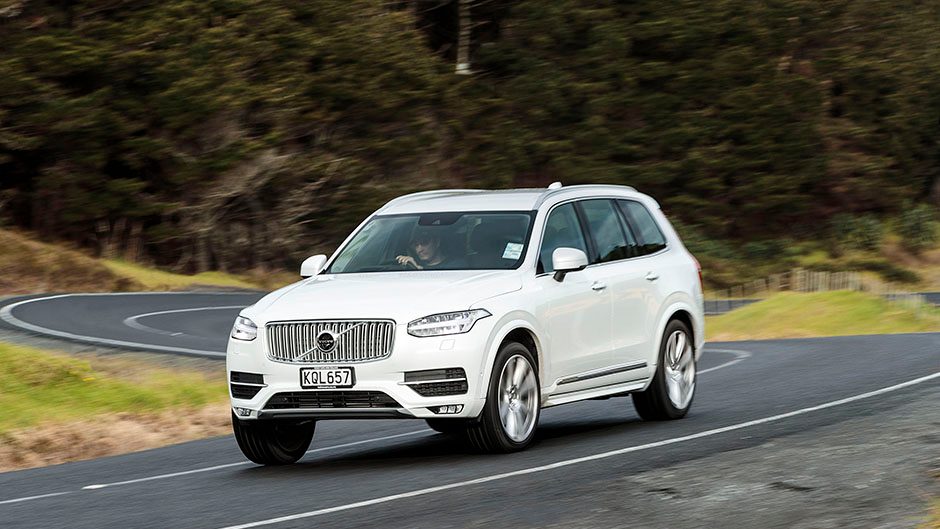
There’s value to be had in all sectors of the market, even at the luxury end, and the XC90’s cost advantage is significant here.The D5 Inscription is $104,990 while the Discovery HSE is $126,900, the off-road hardware of the Land Rover adding cost. There are a few spec differences between them, though both offer the necessary luxuries and safety features, the Volvo with more of the latter as standard. Both have a five-star Euro NCAP rating. But you could load the Volvo up by adding the $2900 Technology Pack (for a 360-degree camera, CarPlay, Head-Up display, and digital radio) and the $9900 Premium Pack (air springs, heated seats for all, upgraded leather interior, and premium B&W sounds). Even so it would still be cheaper than the Disco’s base price. Land Rover has a five-year, 80,000km scheduled service plan included. You’ll pay extra to service the Volvo.
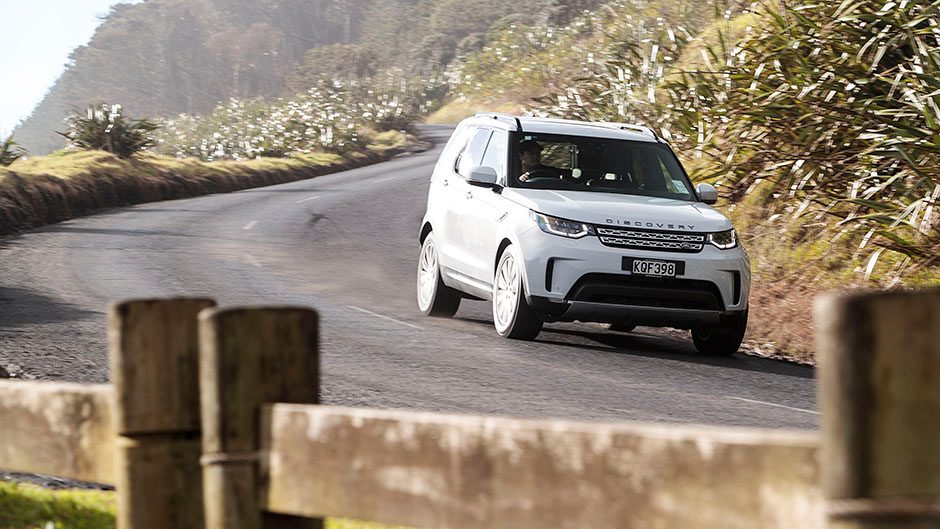
Each has a voluminous cabin, big enough to actually fit seven bodies inside, and versatile seating arrangements, the pews folding and sliding to help everyone fit. The Volvo has more legroom in the middle row, but you’ll fit three across in the Discovery more comfortably. Access to the rear row is slightly better in the Volvo, but there’s more room in the Discovery; a six footer will find space for all their body parts, even if the seat squab is mean on padding. The Volvo however is hardly a squeeze, especially if you slide the second row forwards a few clicks on its runners, and those back seats are rather comfy. Both have a 50/50 split in the third row, and with all the seats in use, you’ll still be able to fit two fat labradors in the boot of the Volvo but you’d struggle to put a handbag dog in the back of the Discovery.
This HSE was fitted with the optional electric seat fold package, which has its pros and cons; you can set the seats with a touch of a button and without having to move all around the vehicle, but the electrics are slow and it’s just something else that might go wrong. The manual levers in the Volvo work well.
As five seaters, the Discovery has a bigger load area in the boot, being slightly taller and wider, but we aren’t sold on the secondary, inner-tailgate Land Rover has installed on the Discovery; it gets in the way more often than not and isn’t particularly comfortable to sit on.
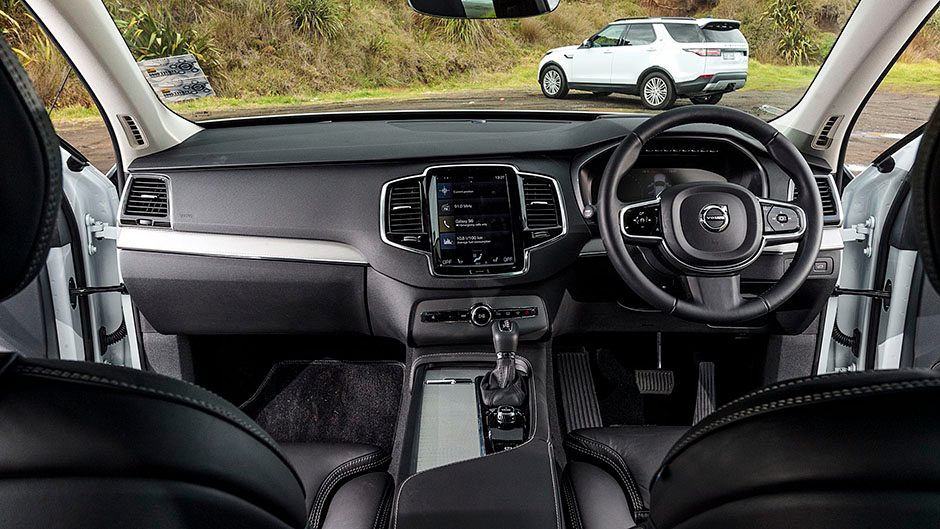
The Discovery leans towards a utilitarian-type luxury with sophisticated surfaces likely to stand up to adventurous outings. It follows LR’s clean approach to cabin design, save for the mess of buttons on the centre console controlling the off-road gubbins. Along with many a recharge point, storage is in good supply, with a few novel solutions, even a secret squirrel spot behind the ventilation controls. The seats are big and comfy, complete with arm rests, though the Nappa leather trimmed seat in the Volvo is preferable. Both have touchscreens, the Volvo’s Sensus system in control of just about everything, and it works marvelously, allowing for a truly uncluttered cabin design. While the plastics used for the XC90’s interior are high quality, the Inscription model is better with the optional leather upgrade, adding hide to the dash and door tops for a Range Rover-like interior feel. About the only thing we don’t like about the XC90 cabin is the steering wheel, for it’s too easy to bump the audio buttons when you’re turning, and you’re left wondering why you’re suddenly listening to a raving Leighton Smith.
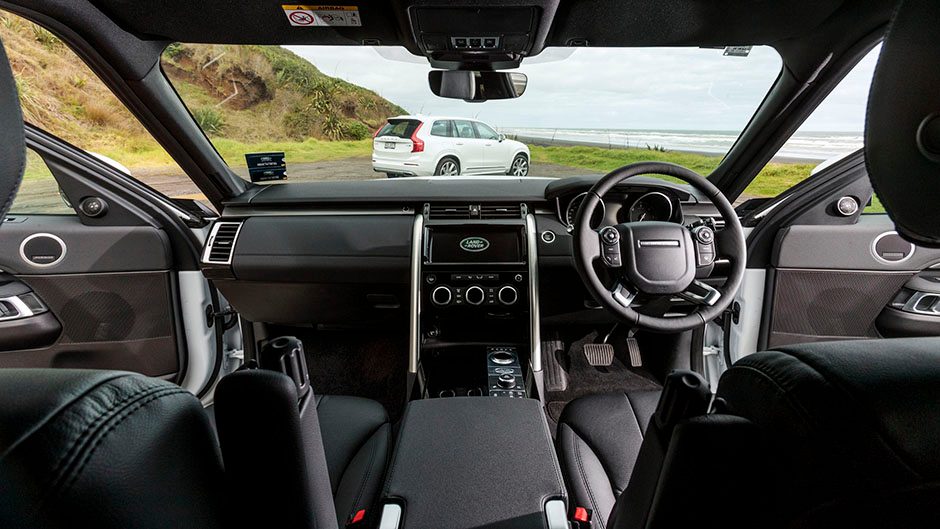
During urban sorties, the Volvo always feels smaller, more wieldy with a lighter, quicker steering action. The Discovery’s steering is more hefty, its ratio slower but with its standard fit air springs, the big SUV rides better. The XC90 on standard suspension isn’t as settled either in urban or rural environs, especially on the optional 21s. There’s also more road noise, whereas the Discovery is a cone of silence.
The lighter Volvo is less prone to roll in faster corners but it isn’t big on feedback. The steering needs more life and without the optional drive mode button you can’t inject it with a sportier character. Still it gets by ok for a big bus, grip is assured and should you overcook things there’s torque vectoring to help you out.
The Disco always feels substantial on the run, there’s more roll but it’s manageable thanks to the feelsome control of the helm, while the air springs do a reasonable job of taming the lean.
While the Discovery is all new, it’s powertrain is revisionary rather than revolutionary. A solitary turbo feeds the 3.0-litre V6 oiler, made more efficient with new injectors, honed internals and exhaust gas recirc to make 190kW and 600Nm. Volvo has a strict four cylinder-only policy and so the D5 is powered by a 173kW, 2.0-litre TDI featuring a pair of turbos to produce 470Nm. It’s also fitted with the firm’s innovative anti-lag device; a can of compressed air. The MY17 XC90 has been upgraded to the Power Pulse engine where a pressurised tank, fed by a compressor, squirts air into the manifold when the turbos need to get spinning in order to minimise turbo lag. Sounds fanciful, but it works.
The smaller engine has the better response with less lag, the Disco still with a moment to wait before its torque slugs you. It makes the Volvo feel a mite more urgent in town running. It’s also a step quicker when going all out, the power and torque advantage of the Disco eroded by its weight as the XC90 is over 400kg lighter. They say that for extra speed add lightness and it’s true even of luxury high riders. The Volvo’s four revs quickly, is stronger than you give its 2.0-litre capacity credit for, and is smooth too. The bigger V6 has more character with a growl about its business and slugs away in an unstressed manner. The Discovery’s auto is smarter, with less work to do, while the Volvo’s could do with a Sport mode on occasion, but both are polished units when commuting. The smaller engine, pushing less weight uses less diesel, averaging in the high eights, while the Discovery settled in the low 10s.
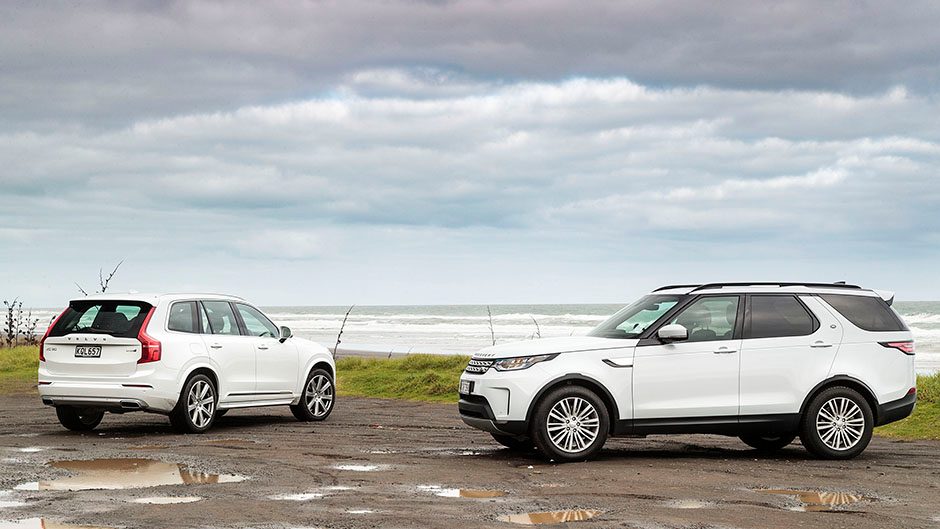
You’ll be more taken by the Land Rover. Get the proper hook, and it’ll haul up to 3500kg braked, though the Volvo isn’t totally out pulled, rated at 2700kg. If you want to get off the track, the Land Rover will take you places. There’s low-range, a trick self-locking centre diff, a selectable traction system to optimise things for the terrain you are covering, and four corner air springs that can ramp the ground clearance right up. It’s more capable than it needs to be really. With the optional air springs, XC90 has an off road mode which raises the ride height slightly, and sends more drive to the rear wheels. But in the Volvo, off road really means on gravel and beaches, which some might say is enough.
This one kind of depends on your needs. Want gob loads of tow and capability, it has to be the Discovery, but if it’s a luxury town car you want, the XC90 is better suited. Personally it’s the latter I’d choose, with nothing to tow and an urban lifestyle, it’s easier to scramble around the suburbs in, just as versatile as a seven-seater, and better value.
| Model | Land Rover Discovery HSE TD6 | Price | $126,900 |
| Engine | 2993cc, V6, TDI, 190kW/600Nm | Drivetrain | 8A, AWD |
| Fuel Use | 7.5L/100km | C02 Output | 195g/km |
| 0-100km/h | 8.91sec | Weight | 2475kg |
| Model | Volvo XC90 TD5 Inscription | Price | $104,900 |
| Engine | 1969cc, IL4, TDI, 173kW/480Nm | Drivetrain | 8A, on-demand AWD |
| Fuel Use | 5.7L/100km | C02 Output | 152g/km |
| 0-100km/h | 8.19sec | Weight | 2087kg |


